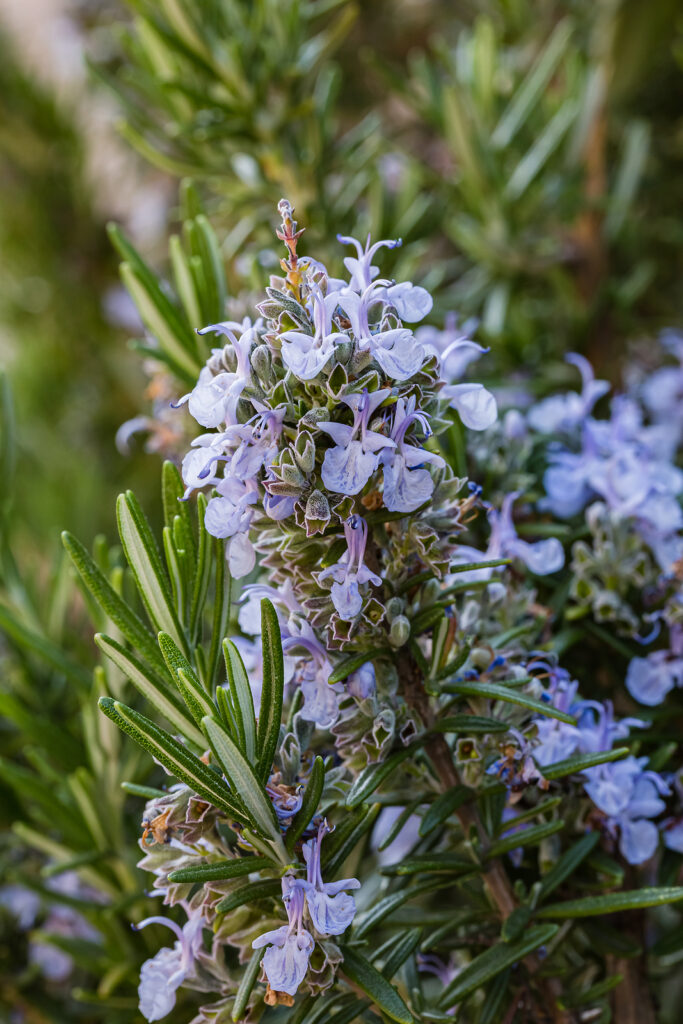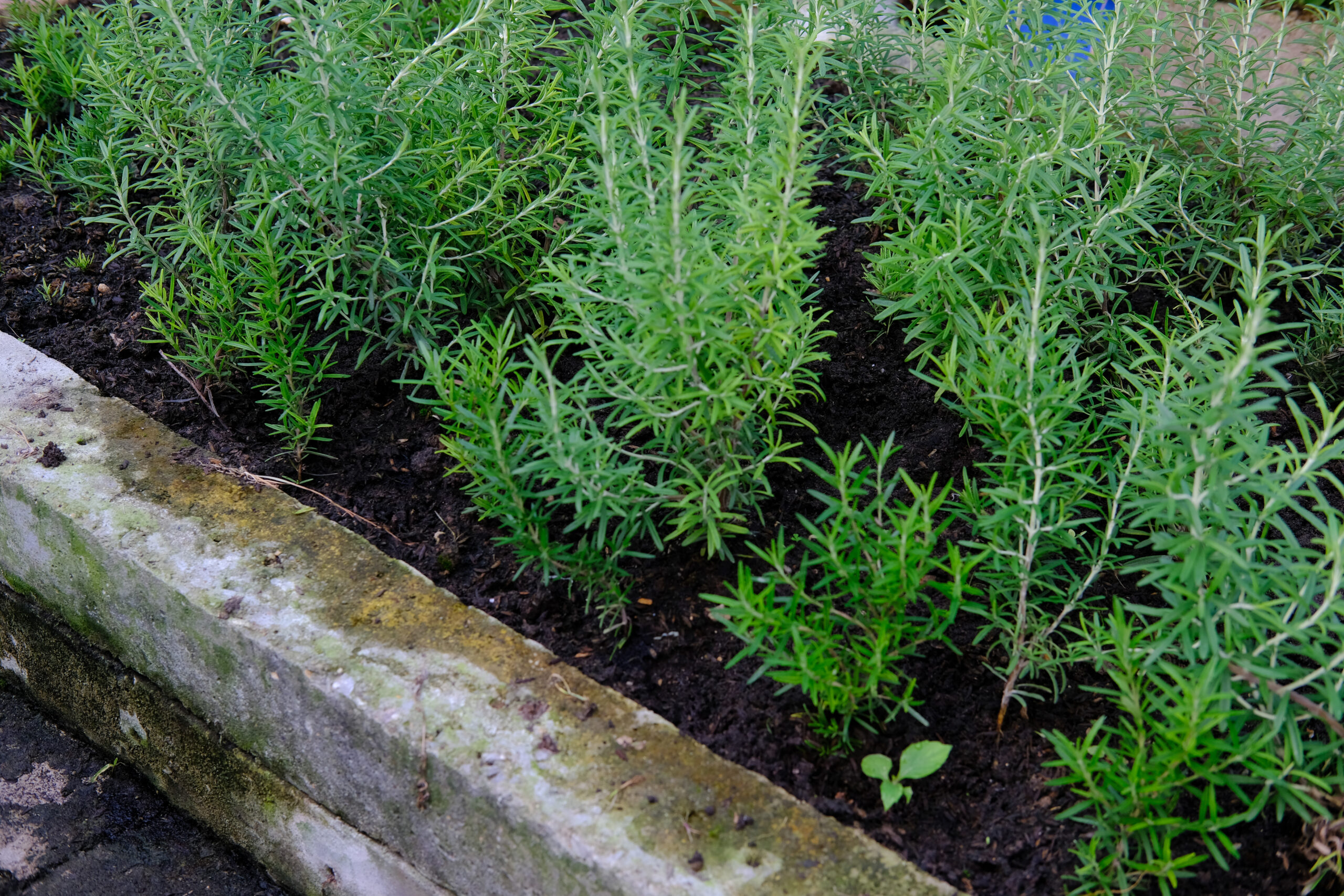Rosmarinus–commonly called Rosemary–is an evergreen shrub that is commonly cultivated for its bright lavender-blue flowers. The narrowly linear leaves are rich in aromatic oil and often included in culinary herb gardens.
Rosmarinus cultivars include both low-growing and tall shrubs. Tall cultivars can be grown in a shrub border, mixed border, or as a hedge. Low-growing cultivars are suited for rock gardens and as ground covers. Rosmarinus is often included in herb gardens. Where Rosmariunus is not hardy, it can be grown as a potted herb indoors.
Rosmarinus must be planted in well-drained soil where rains come in summer. In dry summer regions in can thrive will little supplemental water.
The Rosmarinus genus contains two species of evergreen shrubs from the Mediterranean region (the botanical name means ‘dew of the sea’).
Get to know Rosmarinus
- Plant type: Evergreen shrub or herb
- Growing zones and range: Zones 8 to 11
- Hardiness: Hardy to Zone 8
- Height and width: Size varies with cultivar; some are low growing to12 inches high, other grow to 8 feet or tall.
- Foliage: Narrow, almost needlelike, inch-long leaves usually glossy green above, grayish white beneath, aromatic when brushed or bruised.
- Flowers: Small clusters of small, two-lipped flowers typically lavender blue borne in short, few-flowered axillary whorls.
- Bloom time: Winter to spring.
- Uses: Taller cultivars can be grown in shrub or mixed border or as a hedge; smaller cultivars can be grown in containers or as groundcovers.
- Common name: Rosemary
- Botanical name: Rosmariunus
- Family name: Lamiaceae
- Origin: Mediterranean region

Where to plant Rosmarinus
- Grow Rosmariunus in full sun.
- Rosmarinus will grow in poor to moderately fertile soil that is well drained.
When to plant Rosmarinus
- Set container-grown Rosmariunus in the garden in spring or autumn.
Planting and spacing Rosmariunus
- Space Rosmarinus 36 inches (90cm) to 5 feet (1.5m) apart.
How to water and feed Rosmariunus
- Water Rosmarinus enough to keep the soil just moist; established plants can withstand dry soil and drought.
- Fertilize Rosmariunus with an all-purpose, slow-release organic fertilizer in spring.
Rosmariunus care
- Prune Rosmariunus as needed, making all cuts to side branches or into leafy stems.
Growing Rosmarinus as a houseplant
- Rosmarinus officinalis can be grown as a houseplant; ‘Prostratus’ is low-growing with long stems.
- Grow Rosmariunus where the temperature is average, light is direct and humidity is average.
- Mose Rosmarinus into a cool room in winter.
- Plant in a soilless medium that is allowed to dry slightly between waterings.
- Fertilize every two months from mid-spring to mid-fall.
- Pinch growing tips to keep the plants compact.
- Leaves may be removed at any time and used fresh or dried in cooking.
Rosmariunus pests and diseases
- Rosmariunus is prone to aerial blight, bacterial leaf spot, and root rot.

Rosmariunus propagation
- Sow Rosmariunus seeds in containers in spring in a cold frame.
- Root semi-ripe cuttings in summer.
Rosmariunus varieties to grow
- Rosmarinus officinalis. Rosemary. Species shrub grows 2 to 6 feet tall and bears deep green leathery, needlelike leaves that are white underneath and smell of pine. The tubular, two-lipped blue flowers bloom in the leaf axils in late spring or early summer, often reblooming when weather cools in fall. Popular cultivars are listed below:
- ‘Alba’. Resembles basic species but bears white flowers.
- ‘Arp’. The hardiest rosemary; takes temperatures to -10°F/-23°C. Found in Arp, Texas. Open grower to 4 feet tall; bright blue flowers.
- ‘Benenden Blue’ bears bright blue flowers.
- ‘Collingwood Ingram’ (R. ingramii). Grows 2 to 2 ½ feet tall, spreading to 4 feet wide or more. Branches curve gracefully. Flowers in rich, bright shade of blue violet. Use as a bank or ground cover.
- ‘Golden Rain’ new leaves are edged in gold.
- ‘Huntington Carpet’ (‘Huntington Blue’). Grow to 12 inche tall; spreads quickly yet maintains dense center. Pale blue flowers.
- ‘Ken Taylor’. Resembles ‘Collingwood Ingram’ but is lower growing and has a greater tendency to trail.
- ‘Lockwood de Forest’ (R. lockwoodii, R. forestii). Resembles ‘Prostratus’, but with lighter, brighter foliage and bluer flowers.
- ‘Majorca Pink’. Erect shrub grows 2 to 5 feet tall. Lavender pink flowers.
- ‘Miss Jessup’s Upright’. Upright to 4 feet tall; pale blue flowers. Suitable for formal herb gardens.
- ‘Old Salem’: Dense, erect growth to 3 feet tall.; pale blue flowers; usually cold hardy under snow cover.
- ‘Prostratus’, dwarf rosemary: Trailing plant grows to 2 tall and 4 to 8 feet wide spread; pale lavender blue flowers. Slightly less cold hardy than most other types of rosemary. Good choice for trailing over a wall or as a groundcover.
- ‘Tuscan Blue’: Upright branches grow directly from the base of the plant to 6 feet tall or taller; rich green leaves, blue-violet flowers. Use as a tall, narrow screen.















